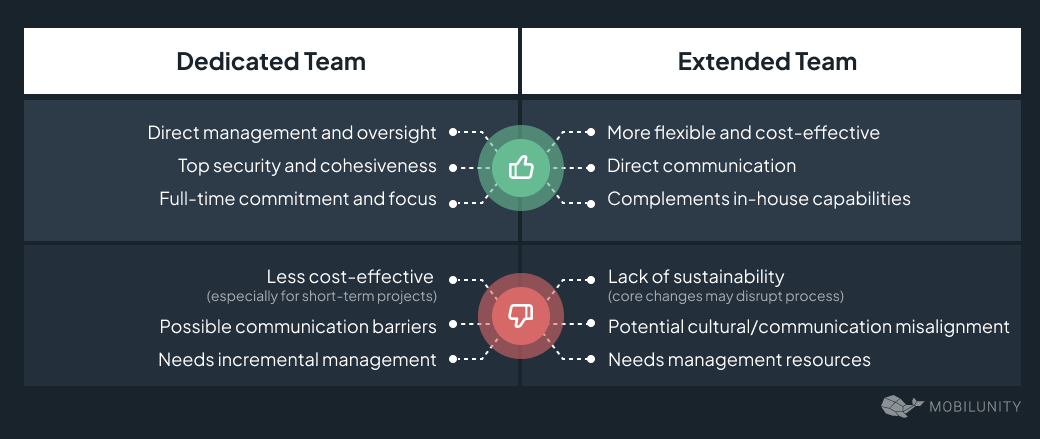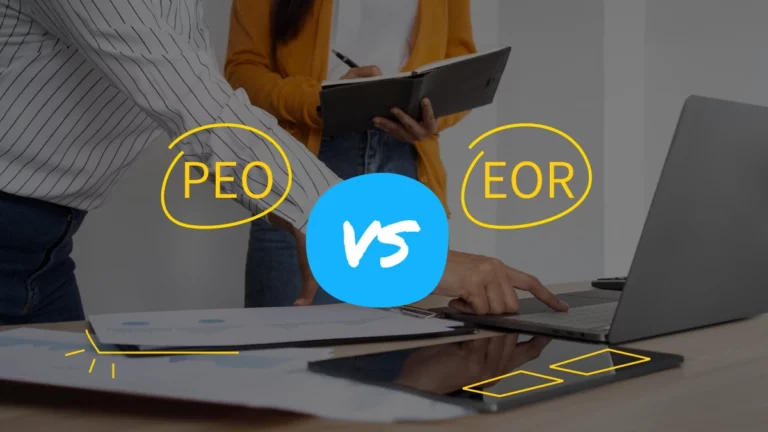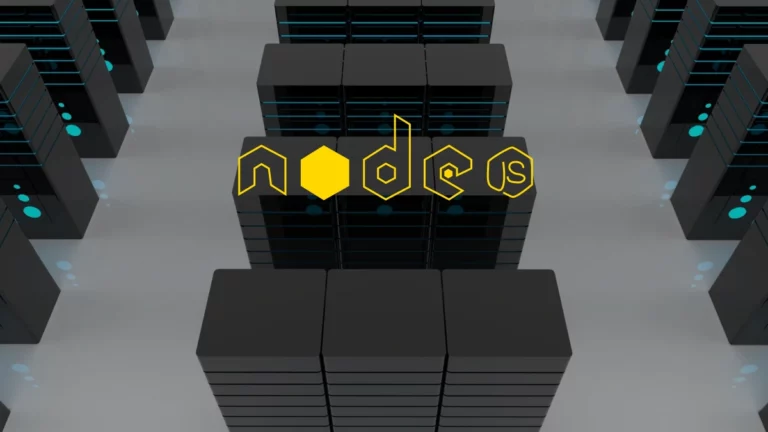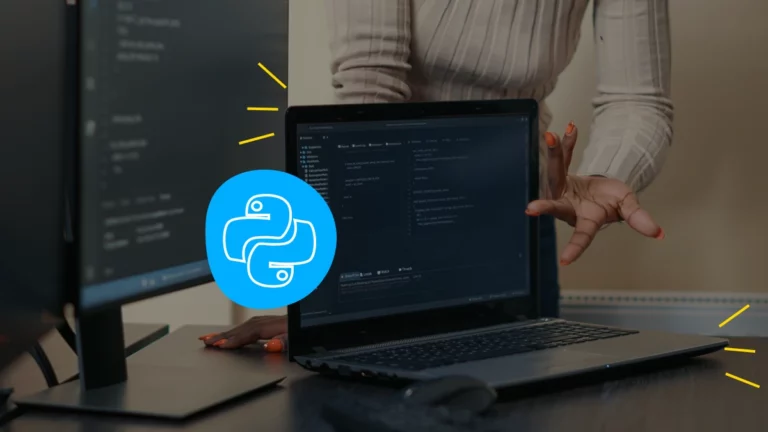Extended Team vs. Dedicated Team Model: Which Works Best for Your Project

Lack of available in-house IT engineering specialists and a huge number of companies looking how to reduce operational costs are the main trends for the current decade.
Grand View Research expects the global market of IT outsourcing services to keep growing by 8.0% annually, to reach $1,180 bn by 2030.
Many business owners refrain from hiring in-house, sourcing, or hiring alone. Most commonly – due to a significant time-consuming HR and management effort. Not to mention the hefty price tags offered by local developers.
Here is exactly when staff augmentation come into play – giving global access to high-quality talents, adding speed and flexibility to fill the gap (e.g. when the company needs to boost capacity with specific skills or wants only a minor team growth).
Below we’re going to explore 2 seemingly similar – yet different – models, backed by actionable tips for decision-makers who need a bigger team. This guide also covers the key considerations for you to pick the model to suit you best and make fully informed decisions.
Understanding the Basics
Software development projects are different, that’s why there are many configurations possible (e.g. in-house trams, dedicated teams, expanded teams) – or even a combination.
NOTE: An in-house crew can give a nice start for most of any software development project.
However, the need for team growth may often involve some specific skills or hard-to-find engineers of high seniority levels. Additionally, your project can be time-sensitive or come up with only a limited budget. That’s why decision-makers who have never worked with different software development models are usually confused when it comes to choosing the right one.
What Is a Dedicated Team
A dedicated team by definition is a group of tech specialists you hire to work on specific projects (software development, web / mobile development, integration, etc.).
A staff composition may be tailored individually to meet your project needs. Working remotely and integrating seamlessly with your existing development crew, a dedicated team is usually built with the following roles:
- Front-end engineer
- Back-end engineer
- Business analyst
- Project manager
- QA engineer
- UI/UX designer.
The key characteristics of your dedicated team are:
- Full-time commitment and 100% focus on your project
- Requires direct management from your side
- Long-term cooperation aligned with your strategy
- Saved costs on administrative tasks and scalability
- Possibility to build a bigger team from scratch.
What Is an Extended Team?
What about team extension services?
It’s a completely different mode of cooperation, where you may reinforce your own team’s capacity even more flexibly. You engage specific talents to serve you long-term, short-term, or for some temporary needs of your project.
Specialists hired within the expanded team model will serve your software project as long as it is necessary. Staying flexible and open to further collaboration, they seamlessly integrate into your development processes.
The key characteristics of your extended team are:
- Wider access to rare and hard-to-find engineers
- Maximum flexibility for scalable development capacity
- Unique ability to immediately fill in any skill gap
- Option for personal management and greater control.
Dedicated Team vs. Extended Team: In a Nutshell
Dedicated Team vs. Extended Development Team: Detailed Comparison
Once the basic differences between dedicated and expanded teams are clear, let’s delve deeper and see their core features: management and control, flexibility and scalability, cost-effectiveness, as well as integration and collaboration.
Management and Control
A dedicated team model suggests your direct management or oversight by the project manager, who is a member of the in-house crew. This may be good when you already have the core team, but the project appears too large or complex to run alone. In this case, a dedicated team becomes a great opportunity to learn and bring in skills missing throughout your internal staff.
An extended team may also need extra management resources. However, here responsibilities are often shared, suggesting a good balance for close collaboration between the core and external teams.
Flexibility and Scalability
A dedicated team looks less flexible, mainly because the model is all about a group of individuals fully dedicated to one project. Usually, it gives you enough flexibility to engage the necessary professionals when you need them. But when the conditions change quickly this approach may not work.
An extended team is much more flexible, making it possible for you to quickly scale up and down as per current project needs. Additionally, the team growth with this model works at its best when you need to hire an expert for a short-term assignment.
Cost-Effectiveness
A dedicated team better suits for long-term projects and high-volume tasks. Due to its dedicated focus, this model is the ultimate cost-effective solution for your long-term strategy.
An extended team introduces a new level of cost-effectiveness for short-term skill needs and specific projects. Unlike a dedicated team, extensions can be built much faster – being easier to introduce and adjust than any other solution.
Integration and Collaboration
A dedicated team is easier to integrate, as it becomes an integral part of your in-house crew. It doesn’t require that much communication, and carries less potential for cultural and language differences.
An extended team not only becomes a part of the project, sharing the company’s vision and leveraging available resources. It’s meant to complement the core team (not substitute it). Both teams collaborate, effectively compensating and complementing the lacking skill sets or rare expertise.
Practical Tips for Choosing the Right Model
When is it the best time to go for a bigger team?
What to look for when opting for a dedicated team?
Below are 4 major steps to help you pick the team extension services.
1. Project Requirements
Start by assessing your project scope and global requirements.
As it’s already mentioned, a dedicated team model tends more to long-term and complex projects.
And vice versa: consider taking on an expanded team model when you need to cover short-term needs or temporary activities. Especially when the scope of your project isn’t that considerable.
2. Internal Capabilities
Evaluate your existing in-house capabilities.
Do you need to support the existing core team expertise? Then your answer is a dedicated team model.
But if you’re looking for additional resources to quickly fill specific skill gaps (or need a single hard-to-find engineer), be sure to go for an extended team.
3. Budget Constraints
What about your budget expectations?
Remember, a dedicated team can be a powerful tool for the lion’s share of software development projects.
However, eventually, it can be much more expensive when compared to other models. An extended development team, on the contrary, offers a good fit for lower-scope projects or decision-makers looking to optimize costs throughout the project.
4. Integration and Collaboration
Consider integration and onboarding, as well as potential collaboration issues.
Although a dedicated team offers great efficiency and amazing focus on your project, it usually takes some time to adjust and completely integrate with your core software crew.
An extended team, in turn, is the best model for quick integration and the closest collaboration between your in-house and external experts.
Real-World Scenarios
While both models have their own advantages and potential drawbacks, it’s important to have a full picture of real-world examples.
Below are some of the top common situations that can benefit from the use of a dedicated and extended development team at their best.
When to Choose a Dedicated Team
- You have a startup that needs to start a software development cycle but cannot afford (or simply not ready) to hire an in-house team. A dedicated team is the best way to get started, quickly building a bigger team from scratch – while you can focus on other important things, such as tech delivery and product promotion.
- You are a large company that already has a core internal team. However, the project appears too large or complex, requiring a considerable overflow to be delegated to from the established in-house crew. Just remember, a dedicated team model is the ultimate solution for large, complex projects that need maximum commitment.
- Your project appears to demand specific expertise, not available in-house or locally. In this situation, the dedicated team offers a good opportunity to engage hard-to-find engineers with rare skills not possessed by the members of your core crew.
When to Go for an Extended Development Team
- You have several short-term projects (especially with tight deadlines). When critical tasks require immediate attention, getting an extended development team will help you get the most out of this model’s flexibility. Eventually, you can always have the right people to address urgent project elements on time.
- When your core team’s expertise is lacking, an expanded team model is the best way to get you covered. External specialists will become a valuable resource that effectively compensates for the lack of a specific skill set or hard-to-find role. Here team growth with this model is the most flexible and controllable solution.
- Your cost-sensitive project needs scalable resources. Remember, expanding your team is commonly the most cost-effective solution to get additional talents on board, especially during short-term or ongoing projects that need a helping hand. Team extension services are the ultimate practical solution to cut costs, especially under a limited budget.
Conclusion
Deciding on the extended development team vs. dedicated team models may be a daunting task – simply because they may look quite similar at first.
However, choosing the right model for your software development project is a critical decision. Your choice should be built with the nature of your project and specific requirements in mind.
A dedicated team becomes an ideal solution when you need people for long-term collaboration, a deep understanding of your business, and a higher dedication – from start to release. On the other hand, an extended development team is the best development model when you need a lot of flexibility and cost-saving.
As a decision-maker or technical leader, consider the scope, the complexity level of your project, as well as the unique benefits of each model you want to capitalize on. Just remember that – ideally – your choice should depend on the pros and cons of an extended team vs. dedicated team, their alignment with your company’s goals, and the optimal resource utilization.















